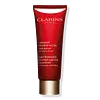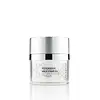What's inside
What's inside
 Key Ingredients
Key Ingredients

 Benefits
Benefits

 Concerns
Concerns

 Ingredients Side-by-side
Ingredients Side-by-side

Water
Skin ConditioningCoco-Caprylate/Caprate
EmollientDicaprylyl Carbonate
EmollientIsononyl Isononanoate
EmollientGlycerin
HumectantButyrospermum Parkii Butter
Skin ConditioningCetearyl Ethylhexanoate
EmollientIsotridecyl Isononanoate
EmollientPentylene Glycol
Skin ConditioningStearyl Heptanoate
EmollientCaprylic/Capric Triglyceride
MaskingC14-22 Alcohols
Emulsion StabilisingHydroxyethyl Acrylate/Sodium Acryloyldimethyl Taurate Copolymer
Emulsion StabilisingCetearyl Alcohol
EmollientDimethicone
EmollientParfum
MaskingPotassium Cetyl Phosphate
EmulsifyingDimethicone/Vinyl Dimethicone Crosspolymer
Skin ConditioningBisabolol
MaskingHexylresorcinol
AntimicrobialC12-20 Alkyl Glucoside
EmulsifyingAvena Sativa Kernel Extract
AbrasiveTocopheryl Acetate
AntioxidantCetearyl Glucoside
EmulsifyingDisodium EDTA
Ethylhexylglycerin
Skin ConditioningButylene Glycol
HumectantDimethiconol
EmollientDehydroacetic Acid
PreservativeSilica
AbrasiveSodium Dehydroacetate
PreservativeHarungana Madagascariensis Extract
Skin ConditioningHelianthus Annuus Extract
EmollientTocopherol
AntioxidantPhenoxyethanol
PreservativeSodium Benzoate
MaskingOlea Europaea Fruit Extract
BleachingSteareth-20
CleansingThermus Thermophillus Ferment
Skin ConditioningCistus Monspeliensis Extract
MaskingLapsana Communis Flower/Leaf/Stem Extract
Skin ConditioningPotassium Sorbate
PreservativeCamellia Sinensis Leaf Extract
AntimicrobialCI 14700
Cosmetic ColorantSodium Lauryl Sulfate
CleansingAcetyl Tetrapeptide-2
Skin ConditioningDextran
Water, Coco-Caprylate/Caprate, Dicaprylyl Carbonate, Isononyl Isononanoate, Glycerin, Butyrospermum Parkii Butter, Cetearyl Ethylhexanoate, Isotridecyl Isononanoate, Pentylene Glycol, Stearyl Heptanoate, Caprylic/Capric Triglyceride, C14-22 Alcohols, Hydroxyethyl Acrylate/Sodium Acryloyldimethyl Taurate Copolymer, Cetearyl Alcohol, Dimethicone, Parfum, Potassium Cetyl Phosphate, Dimethicone/Vinyl Dimethicone Crosspolymer, Bisabolol, Hexylresorcinol, C12-20 Alkyl Glucoside, Avena Sativa Kernel Extract, Tocopheryl Acetate, Cetearyl Glucoside, Disodium EDTA, Ethylhexylglycerin, Butylene Glycol, Dimethiconol, Dehydroacetic Acid, Silica, Sodium Dehydroacetate, Harungana Madagascariensis Extract, Helianthus Annuus Extract, Tocopherol, Phenoxyethanol, Sodium Benzoate, Olea Europaea Fruit Extract, Steareth-20, Thermus Thermophillus Ferment, Cistus Monspeliensis Extract, Lapsana Communis Flower/Leaf/Stem Extract, Potassium Sorbate, Camellia Sinensis Leaf Extract, CI 14700, Sodium Lauryl Sulfate, Acetyl Tetrapeptide-2, Dextran
Water
Skin ConditioningGlycerin
HumectantCaprylic/Capric Triglyceride
MaskingC13-15 Alkane
SolventSqualane
EmollientC12-16 Alcohols
EmollientCetearyl Alcohol
EmollientDimethicone
EmollientNiacinamide
SmoothingPalmitoyl Hexapeptide-12
Skin ConditioningPalmitoyl Tripeptide-1
Skin ConditioningAcetyl Tetrapeptide-2
Skin ConditioningPhosphatidylserine
Emulsion StabilisingOleuropein
AntioxidantCeramide NP
Skin ConditioningLinum Usitatissimum Seed Extract
PerfumingPlantago Lanceolata Leaf Extract
AntimicrobialPeucedanum Graveolens Extract
TonicButyrospermum Parkii Butter Extract
Skin ConditioningTremella Fuciformis Sporocarp Extract
AntioxidantHydroxymethoxyphenyl Decanone
Skin ConditioningBetaine
HumectantAscorbyl Palmitate
AntioxidantOlea Europaea Leaf Extract
PerfumingDunaliella Salina Extract
Skin ConditioningPersea Gratissima Fruit Extract
EmollientPhospholipids
Skin ConditioningBentonite
AbsorbentPalmitic Acid
EmollientHydrogenated Lecithin
EmulsifyingTocopherol
AntioxidantXanthan Gum
EmulsifyingCaprylyl Glycol
EmollientCaprylyl Methicone
Skin ConditioningButylene Glycol
HumectantLecithin
EmollientSclerotium Gum
Emulsion StabilisingPullulan
Polyglyceryl-10 Stearate
Skin ConditioningSucrose Stearate
EmollientDisodium EDTA
Ethylhexylglycerin
Skin ConditioningCaprylhydroxamic Acid
Phenoxyethanol
PreservativeWater, Glycerin, Caprylic/Capric Triglyceride, C13-15 Alkane, Squalane, C12-16 Alcohols, Cetearyl Alcohol, Dimethicone, Niacinamide, Palmitoyl Hexapeptide-12, Palmitoyl Tripeptide-1, Acetyl Tetrapeptide-2, Phosphatidylserine, Oleuropein, Ceramide NP, Linum Usitatissimum Seed Extract, Plantago Lanceolata Leaf Extract, Peucedanum Graveolens Extract, Butyrospermum Parkii Butter Extract, Tremella Fuciformis Sporocarp Extract, Hydroxymethoxyphenyl Decanone, Betaine, Ascorbyl Palmitate, Olea Europaea Leaf Extract, Dunaliella Salina Extract, Persea Gratissima Fruit Extract, Phospholipids, Bentonite, Palmitic Acid, Hydrogenated Lecithin, Tocopherol, Xanthan Gum, Caprylyl Glycol, Caprylyl Methicone, Butylene Glycol, Lecithin, Sclerotium Gum, Pullulan, Polyglyceryl-10 Stearate, Sucrose Stearate, Disodium EDTA, Ethylhexylglycerin, Caprylhydroxamic Acid, Phenoxyethanol
Ingredients Explained
These ingredients are found in both products.
Ingredients higher up in an ingredient list are typically present in a larger amount.
This peptide is more commonly known as Thymulen 4 BG.
It is derived from a youth hormone called thymopoietin. Thymopoietin helps regulate the immune system and decreases naturally with age.
According to the manufacturer, this peptide boosts the skin's immune defenses and regenerates the outer layers of skin.
Learn more about Acetyl Tetrapeptide-2Butylene Glycol (or BG) is used within cosmetic products for a few different reasons:
Overall, Butylene Glycol is a safe and well-rounded ingredient that works well with other ingredients.
Though this ingredient works well with most skin types, some people with sensitive skin may experience a reaction such as allergic rashes, closed comedones, or itchiness.
Learn more about Butylene GlycolThis ingredient is an emollient, solvent, and texture enhancer. It is considered a skin-softener by helping the skin prevent moisture loss.
It helps thicken a product's formula and makes it easier to spread by dissolving clumping compounds.
Caprylic Triglyceride is made by combining glycerin with coconut oil, forming a clear liquid.
While there is an assumption Caprylic Triglyceride can clog pores due to it being derived from coconut oil, there is no research supporting this.
Learn more about Caprylic/Capric TriglycerideCetearyl alcohol is a mixture of two fatty alcohols: cetyl alcohol and stearyl alcohol. It is mainly used as an emulsifier. Emulsifiers help prevent the separation of oils and products. Due to its composition, it can also be used to thicken a product or help create foam.
Cetearyl alcohol is an emollient. Emollients help soothe and hydrate the skin by trapping moisture.
Studies show Cetearyl alcohol is non-toxic and non-irritating. The FDA allows products labeled "alcohol-free" to have fatty alcohols.
This ingredient is usually derived from plant oils such as palm, vegetable, or coconut oils. There is debate on whether this ingredient will cause acne.
Due to the fatty acid base, this ingredient may not be Malassezia folliculitis safe.
Learn more about Cetearyl AlcoholDimethicone is a type of synthetic silicone created from natural materials such as quartz.
What it does:
Dimethicone comes in different viscosities:
Depending on the viscosity, dimethicone has different properties.
Ingredients lists don't always show which type is used, so we recommend reaching out to the brand if you have questions about the viscosity.
This ingredient is unlikely to cause irritation because it does not get absorbed into skin. However, people with silicone allergies should be careful about using this ingredient.
Note: Dimethicone may contribute to pilling. This is because it is not oil or water soluble, so pilling may occur when layered with products. When mixed with heavy oils in a formula, the outcome is also quite greasy.
Learn more about DimethiconeDisodium EDTA plays a role in making products more stable by aiding other preservatives.
It is a chelating agent, meaning it neutralizes metal ions that may be found in a product.
Disodium EDTA is a salt of edetic acid and is found to be safe in cosmetic ingredients.
Learn more about Disodium EDTAEthylhexylglycerin (we can't pronounce this either) is commonly used as a preservative and skin softener. It is derived from glyceryl.
You might see Ethylhexylglycerin often paired with other preservatives such as phenoxyethanol. Ethylhexylglycerin has been found to increase the effectiveness of these other preservatives.
Glycerin is already naturally found in your skin. It helps moisturize and protect your skin.
A study from 2016 found glycerin to be more effective as a humectant than AHAs and hyaluronic acid.
As a humectant, it helps the skin stay hydrated by pulling moisture to your skin. The low molecular weight of glycerin allows it to pull moisture into the deeper layers of your skin.
Hydrated skin improves your skin barrier; Your skin barrier helps protect against irritants and bacteria.
Glycerin has also been found to have antimicrobial and antiviral properties. Due to these properties, glycerin is often used in wound and burn treatments.
In cosmetics, glycerin is usually derived from plants such as soybean or palm. However, it can also be sourced from animals, such as tallow or animal fat.
This ingredient is organic, colorless, odorless, and non-toxic.
Glycerin is the name for this ingredient in American English. British English uses Glycerol/Glycerine.
Learn more about GlycerinPhenoxyethanol is a preservative that has germicide, antimicrobial, and aromatic properties. Studies show that phenoxyethanol can prevent microbial growth. By itself, it has a scent that is similar to that of a rose.
It's often used in formulations along with Caprylyl Glycol to preserve the shelf life of products.
Tocopherol (also known as Vitamin E) is a common antioxidant used to help protect the skin from free-radicals and strengthen the skin barrier. It's also fat soluble - this means our skin is great at absorbing it.
Vitamin E also helps keep your natural skin lipids healthy. Your lipid skin barrier naturally consists of lipids, ceramides, and fatty acids. Vitamin E offers extra protection for your skin’s lipid barrier, keeping your skin healthy and nourished.
Another benefit is a bit of UV protection. Vitamin E helps reduce the damage caused by UVB rays. (It should not replace your sunscreen). Combining it with Vitamin C can decrease sunburned cells and hyperpigmentation after UV exposure.
You might have noticed Vitamin E + C often paired together. This is because it is great at stabilizing Vitamin C. Using the two together helps increase the effectiveness of both ingredients.
There are often claims that Vitamin E can reduce/prevent scarring, but these claims haven't been confirmed by scientific research.
Learn more about TocopherolWater. It's the most common cosmetic ingredient of all. You'll usually see it at the top of ingredient lists, meaning that it makes up the largest part of the product.
So why is it so popular? Water most often acts as a solvent - this means that it helps dissolve other ingredients into the formulation.
You'll also recognize water as that liquid we all need to stay alive. If you see this, drink a glass of water. Stay hydrated!
Learn more about Water